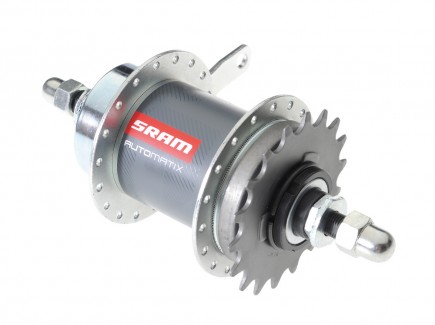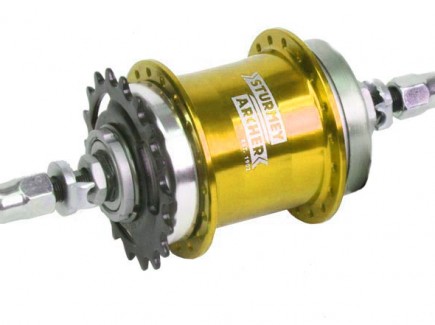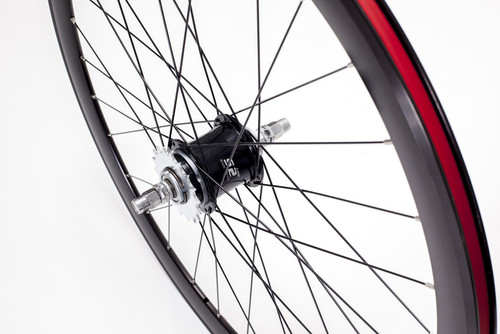If you’re finding the gearing range of your single-speed a bit limiting, there are a couple of options. But which works best in the real world? Iain Treloar tests and reports back.
Anyone riding a single-speed is likely to have, at some point, encountered the point where an extra gear would be really nice. Usually, however, dedicated single-speed frames don’t have the necessary lugs for cable routing, making the fitting of a shifter-activated internally-geared hub an ugly, cable-tie-heavy exercise.
There are, however, two models on the market that give you the convenience of a geared hub without the faff of fitting a shifter. These are the Sturmey Archer S2 Duomatic, and the SRAM Automatix. Both of these fill a similar niche, as they’re two-speed internal hubs without any shifter at the handlebar. However, their real-world function is quite different. Having spent quite a bit of time on both systems, this comparison is designed to help guide your choice.
Both hubs are clean in appearance, cost a similar amount, and fit on the bike in the same way.
SRAM Automatix

The SRAM Automatix (distributed in Australia by Monza Imports, for roller [$129.95] or coaster brakes [$279]) is a smooth, quiet and clever automatic hub gear. In theory, this seems like the perfect gearing solution for those used to a single-speed. However the shift point of the hub comes far too early (around 18km/h) and a flat cruising speed puts you at a low cadence that soon feels like a real slog. The fact that it’s an automatic shift at first seems like a plus, but the lack of autonomy becomes a bit grating. The hub, of course, can’t know whether you’re battling a headwind, wanting an easy spin home after a tough day, or if your legs are about to conk out. Rather than easing your worries, you end up anticipating the shift point with a certain dread, because most of the time it doesn’t bring relief but more effort. Of further frustration is the fact that only the up-shift is automatic—to make it shift down again, you need to stop pedaling momentarily, which means you’re losing speed and momentum halfway up a hill. Although you can’t change the shift point of the hub gears, you can change the cadence needed to push them with a smaller chainring. Although the quality of the system is high, my real-world experience with the SRAM Automatix left much to be desired—it’s just a little too clever for its own good and, if you’re anything but the most passive rider, soon becomes annoying. The fact that there’s no rim-brake version brought into Australia means that, although you can get rid of your rear brake caliper, you’re left with the compromised braking performance and action of a coaster brake.
Sturmey Archer S2 Duomatic

The Sturmey Archer S2 Duomatic is activated by a backwards kick, which requires a bit of practice to find. It’s a fairly subtle motion, with a defined click to let you know that you’ve reached your shift-point. The auditory signal is the best pointer to use, as there’s little indication through the drivetrain. There are some pros and cons to this set-up; it brings back the autonomy that the SRAM Automatic removes, but complicates low-speed manoeuvres. It’s only when your attention is drawn to it that you realise just how often you back-pedal in the course of your urban riding—positioning your pedals for corners or red-lights, or getting your feet into cages (if you ride with them)—and the Duomatic forces a rethink of each of these motions, lest you trigger a shift that puts you in the high gear when you really want the low one. However, when you actually have a stretch of open road ahead of you, I far preferred the Duomatic to the Automatix. The low gear was suitable on a 44/17t ratio for most pottering about the hilly streets of my area, or when carrying a load of shopping; the high gear offered a suitable alternative for dropping the hammer or downhill. The cog at the back is for a 1/8” chain, not a 3/32” (which I had on my bike) so factor in the expense of a chain if you’re in the same boat. The Duomatic hub is available for coaster brake, freewheel (rim brake) or 6-bolt disc, retailing for around the $170–$180 mark (distributed in Australia by Bicycle Parts Wholesale). Factoring in the cost of a wheelbuild, the cheap and cheerful option is to buy a complete wheel from Cell ($169, feature image) with a heavy but solid deepish profile rim available in a number of different colours. Cell use the non-coaster (i.e. rim brake) variant of the hub, which positions it as a convenient aftermarket upgrade for most single-speed users. The braking on the Cell rim lacks a little bite, but the value for money of the complete setup is undeniable and makes for a really easy and affordable swap-over.
Conclusion
In all, the decision as to which one is best for you will come down to what sort of rider you are. The SRAM Automatix is a smoother, more polished system, but it’s almost too clever for its own good and if you’re used to having a degree of control over your own cadence, you’ll find its independent nature very annoying. Sturmey Archer’s hub is a little more old-school in its look and feel, and the shifting isn’t 100% predictable/repeatable, even with practice. However, at least you’ve got some control over the fact that it’s shifting. In essence, the Automatix demands less of you as a rider but takes more; the Duomatic is the exact opposite.
Ride On content is editorially independent, but is supported financially by members of Bicycle Network. If you enjoy our articles and want to support the future publication of high-quality content, please consider helping out by becoming a member.


Great article on two speeds, or you could ride a retro-direct to be totally different from the crowd.
Thanks Scott! Indeed, anyone curious about the retro-direct system should check out the write-up of Scott’s very interesting bike here – https://rideonmagazine.com.au/my-bike-retro-direct/
it is quite easy to improve SRAM Automatix. I changed the spring inside the hub and now switching for higher gear is around 30km/h.
I also stretched the spring on my Automatix so that it changes at high cadence, there are a couple of howto’s online. It is always in low gear when starting from the lights, I run 44t chainring and 18t cog. I’ve been riding it daily for a couple of years now, never had any issues. You can run 3/32″ or 1/8″ sprockets, they are the same as sturmey or Nexus. Disc brake and freewheel versions are available online. I’ve recently bought the aluminium bodied disc brake version and am in the process of building it into a wheel. A coaster brake means you can’t back pedal at the lights which I find a little annoying.